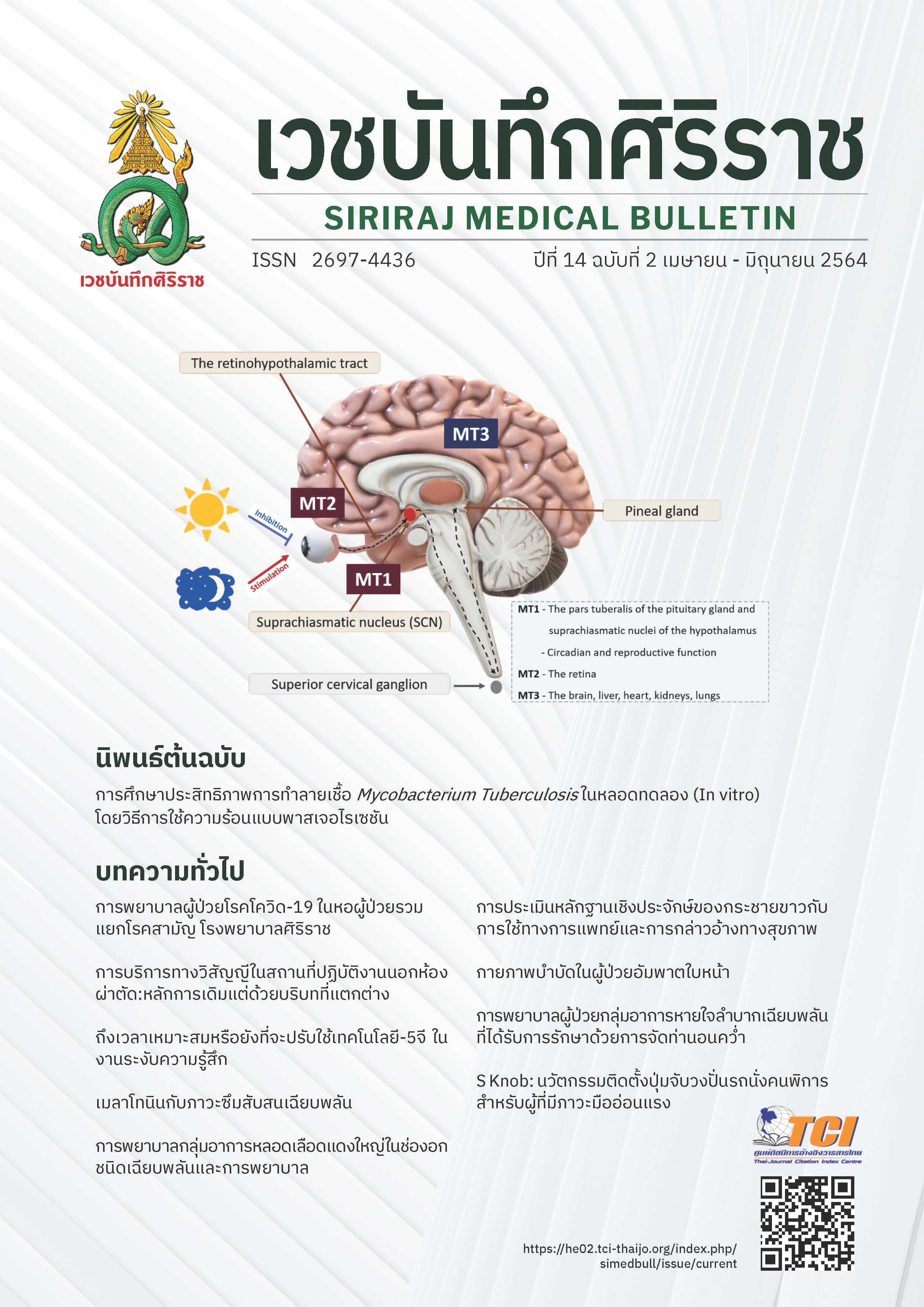S Knob: นวัตกรรมปุ่มช่วยเข็นติดวงปั่นรถนั่งคนพิการสำหรับผู้ป่วยอัมพาตแขนขา
Main Article Content
บทคัดย่อ
การเข็นรถนั่งคนพิการได้ด้วยตนเองในผู้ป่วยอัมพาตแขนขา จะเป็นการส่งเสริมให้ผู้ป่วยสามารถเข้าสู่สังคมได้มากขึ้น อย่างไรก็ตามในผู้ป่วยกลุ่มนี้จะมีภาวะแขนและมืออ่อนแรง ไม่สามารถเข็นรถนั่งคนพิการได้ด้วยตนเอง ส่งผลกระทบต่อการทำกิจวัตรประจำวัน การเข้าสังคม และส่งผลกระทบต่อจิตใจได้ รถนั่งคนพิการที่มีปุ่มช่วยเข็นยื่นออกจากวงปั่น จะช่วยให้ผู้ป่วยกลุ่มนี้สามารถเข็นรถได้ง่ายขึ้น แต่รถนั่งคนพิการชนิดนี้มักมีราคาสูงมาก ดังนั้น ผู้เขียนจึงคิดนวัตกรรม S Knob ซึ่งเป็นปุ่มช่วยเข็นติดวงปั่นรถนั่งคนพิการสำหรับผู้ป่วยอัมพาตแขนขาให้สามารถเข็นรถได้ด้วยตนเอง ราคาไม่แพง และสะดวกต่อการติดตั้งให้สามารถนำไปติดตั้งเองที่บ้านได้ ผลจากการติดตั้งและการนำ S Knob ไปใช้ ทำให้ผู้ป่วยอัมพาตแขนขาสามารถเข็นรถนั่งคนพิการด้วยตนเองในพื้นที่ราบได้ดีขึ้น ทั้งไปข้างหน้า เข็นถอยหลัง หมุนรถ 360 องศา และเลี้ยวรถไปด้านซ้ายและขวาได้ เมื่อทำแบบสอบถามความพึงพอใจของผู้ป่วยภายหลังการใช้งาน พบว่ามีความพึงพอใจร้อยละ 90 และช่วยลดค่าใช้จ่ายในการจัดซื้อวงปั่นที่มีปุ่มช่วยเข็นแบบสำเร็จรูปที่มีราคาแพง อย่างไรก็ตามนวัตกรรมนี้ยังไม่สามารถช่วยผู้ป่วยอัมพาตแขนขาเข็นรถนั่งคนพิการได้อย่างอิสระในพื้นที่ลาดหรือพื้นที่ขรุขระ จึงควรมีผู้ดูแลและช่วยเหลือเมื่อต้องเข็นเพื่อป้องกันการเกิดอันตราย
Article Details
เอกสารอ้างอิง
ทศพร บรรยมาก. กิจกรรมบำบัดในผู้ได้รับบาดเจ็บไขสันหลัง. ใน: พิศักดิ์ ชินชัย, บรรณาธิการ. กิจกรรมบำบัดสำหรับผู้ที่มีปัญหาด้านระบบประสาท. พิมพ์ครั้งที่ 4. เชียงใหม่: ภาควิชากิจกรรมบำบัด มหาวิทยาลัยเชียงใหม่; 2560. หน้า 227-252.
Khasnabis C, Mines K, editors. Wheelchair service training package – basic level. Geneva: WorldHealth Organization; 2012. p.1
World Health Organization. Guidelines on the provision of manual wheelchairs in less resourced settings. World Health Organization; 2008. p.37-93
Tamplin J, Baker FA, Grocke D, Brazzale DJ, Pretto JJ, Ruehland WR, et. al. Effect of singing on respiratory function, voice, and mood after quadriplegia: a randomized controlled trial. Arch Phys Med Rehabil 2013; 94(3): 426-34.
สยาม ทองประเสริฐ. อุปกรณ์ช่วยการเคลื่อนที่. [อินเทอร์เน็ต]. 2561 [เข้าถึงเมื่อ 8 ก.ค.2563]. เข้าถึงได้จาก: https://w1.med.cmu.ac.th/rehab/images/Study_guide/06.1%20mobility%20aids.pdf
WheelchairParts.Net [Internet]. 2021 [cite 2021 Mar 2]. Available from:
https://wheelchairparts.net/projection-handrims/?fullSite=1
ทศพร บรรยมาก. การประเมินความแข็งแรงของกล้ามเนื้อ. ใน: พิศักดิ์ ชินชัย, บรรณาธิการ. กิจกรรมบำบัดสำหรับผู้ที่มีปัญหาด้านระบบประสาท. พิมพ์ครั้งที่ 4. เชียงใหม่: ภาควิชากิจกรรมบำบัด มหาวิทยาลัยเชียงใหม่; 2560. หน้า 31-36.
คณะกรรมการวิชาชีพสาขากิจกรรมบำบัด. แนวปฏิบัติทางคลินิกกิจกรรมบำบัดสำหรับผู้รับบริการโรคหลอดเลือดสมอง. พิมพ์ครั้งที่ 1. กรุงเทพฯ: 2555. หน้า 83-4.
Dalhousie University. Wheelchair Skills Program (WSP) Version 4.3.1 [Internet]. 2015 [cited 8 March 2019]. Available from: http://www.wheelchairskillsprogram.ca/en/skills-manualforms-version-4-3-1/;
Yeo SS, Kwon JW. Wheelchair skills training for functional activity in adults with cervical spinal cord injury. Int J Sports Med 2018; 39(12): 924-8.


